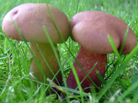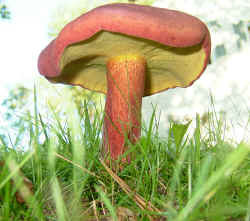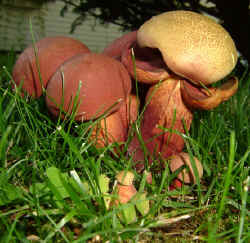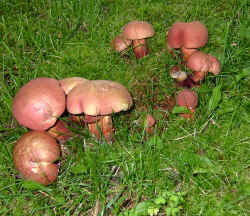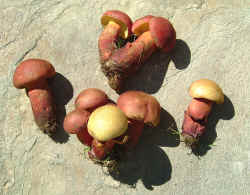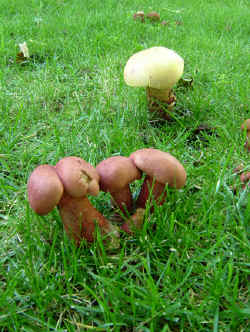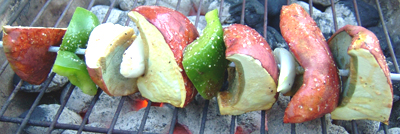|
|
A New England and Eastern Canada Edible and Medicinal Mushroom Resource |
|
Home
Chanterelle (Cantharellus cibarius) Black Trumpet (Craterellus cornucopioides, C. cenerius, C. foetidus) Small Chanterelles (Craterellus tubaeformis, C. ignicolor) Hedgehog (Hydnum repandum, H. umbilicatum) Horse and Meadow Mushroom (Agaricus arvensis, A campestris) Parasol Mushroom (Macrolepiota procera) Shaggy Mane (Coprinus comatus) (White) Matsutake (Tricholoma magnivelare) Blewit (Lepista nuda) Oyster Mushroom (Pleurotus ostreatus, P. populinus)
King Bolete (Boletus edulis) Boletus variipes and other. Two Colored Bolete (Boletus bicolor) Maitake (Grifola frondosa) Chicken of the Woods (Laetiporus sulphureus) Dryads Saddle (Polyporus squamosus)
Morels (Morchella esculenta, M. elata) Puffballs (Calvatia gigantea, Calvatia cyathiformis, others) Lobster Mushroom (Hypomyces lactifluorum) Aborted Entoloma (Entoloma abortivum)
Medicinal Mushrooms Maitake (Grifola frondosa) Reishi (Ganoderma tsugae, G. lucidum) Turkey Tail (Trametes versicolor) Chaga (Inonotus obliquus) Artist's Conk (Ganoderma applanatum)
Collecting, Photographing and
Cooking Collecting
Tips Evaluating
Flavor Dyeing Fabrics and Paper with Mushrooms
|
Two Colored Bolete
The two colored bolete is a beautiful mushroom to discover. It is quite showy with it's red and yellow colors. It is an outstanding edible. Cap (pileus) 2-6 in" wide and pinkish to dark red often with some yellow tones near the margin. Convex when young and flattening with age, smooth and dry at first with a somewhat velvety surface often cracking with age. As seen below, in rare cases the cap can be yellow. Pores are yellow slowly bruising blue. The blue bruising can tend to lighten after a few minutes turning to a tan color. Stem (stipe): The pink or red stem can be quite thick and club shaped occasionally splitting as seen below. It can thin a bit becoming more cylindrical as it grows with yellow tones mostly near the top of the stem. Flesh is strongly yellow may slowly bruise blue or not. Spores are brown. When and where to find them (ecology): I found examples shown between a norway maple and a yew. They can grow in profusion, often coming up in several flushes from the end of July to mid September. They are mycorrhizal often associating with oak and other hardwoods. They grow separately and in small clusters. Preparation These are a truly excellent edible ranking higher than the king bolete (Boletus edulis) in my view. In addition to great flavor they have great eye appeal on the plate with their bright yellow, dense, flesh edged in red. A real show stopper. Younger dense specimens have a pleasant crunchy texture. Any slight bluishness tends to disappear during cooking. I have sautéed, fried, grilled and microwaved these with excellent results. They dry and re hydrate well. Comments This is one of the best edibles you will find! It is versatile to cook with. It's unique flavor is not easily lost in complex dishes. It can be mixed with many types of foods (although mixing with buttons/cremini/portobello would be a shame). The colors are awesome! They do bear some resemblance to Boletus sensibilis which is poisonous. B. sensibilis bruises strongly blue immediately. B. subvetipes has orange or red pores and is also poisonous bruising strongly blue to blue-black immediately. Red and orange pored boletes should not be eaten. Beginners should also stay away from any strongly blue staining mushrooms. Find more information here: Boletus
bicolor at MushroomExpert.com
Use of this site will constitute your acceptance of the disclaimer. Copyright 2012 Mushroom-Collecting.com. All rights reserved. |
